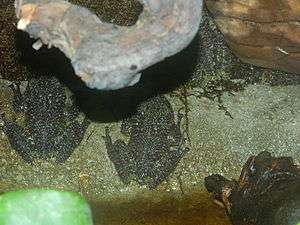Theloderma corticale
| Theloderma corticale | |
|---|---|
.jpg) | |
| Theloderma corticale | |
| Scientific classification | |
| Kingdom: | Animalia |
| Phylum: | Chordata |
| Class: | Amphibia |
| Order: | Anura |
| Family: | Rhacophoridae |
| Subfamily: | Rhacophorinae |
| Genus: | Theloderma |
| Species: | T. corticale |
| Binomial name | |
| Theloderma corticale (Boulenger, 1903) | |
| Synonyms | |
|
Rhacophorus corticalis Boulenger, 1903 | |
Theloderma corticale (common names: mossy frog,[2] Vietnamese mossy frog,[3] and Tonkin bug-eyed frog) is a species of frog in the Rhacophoridae family. It is found in northern Vietnam and possibly in China and adjacent Laos.[4]

Description
The common name "mossy frog" arises from the fact that its skin is a mottled green and brown that resembles moss growing on rock, and forms an effective form of camouflage. They have large sticky pads on their toes and a soft underbelly. The females will grow larger than the males and can reach sizes of 8–9 cm (3.1–3.5 in). This species will curl into a ball when frightened, and play dead.[2][3]
Habitat and conservation
Its natural habitats are primary evergreen rainforests. It is a semi-aquatic that is found in caves and steep rocky cliffs. Breeding takes place in rock cavities or tree holes.[1][2][3]
Its habitat is threatened by forest loss. It is also collected for international pet trade.[1] Like many amphibians, the Vietnamese Mossy Frog is vulnerable to the Chytrid Fungus Batrachochytrium dendrobatidis.
Diet
Theloderma corticale is insectivorous.[3]
References
- 1 2 3 van Dijk, P.P. & Bain. R. (2004). "Theloderma corticale". IUCN Red List of Threatened Species. Version 2015.2. International Union for Conservation of Nature. Retrieved 6 September 2015.
- 1 2 3 "Mossy Frog (Theloderma corticale)". World Association of Zoos and Aquariums. Retrieved 6 September 2015.
- 1 2 3 4 "Vietnamese Mossy Frog (Theloderma corticale)". Newquay Zoo. Retrieved 6 September 2015.
- ↑ Frost, Darrel R. (2015). "Theloderma corticale (Boulenger, 1903)". Amphibian Species of the World: an Online Reference. Version 6.0. American Museum of Natural History. Retrieved 6 September 2015.
